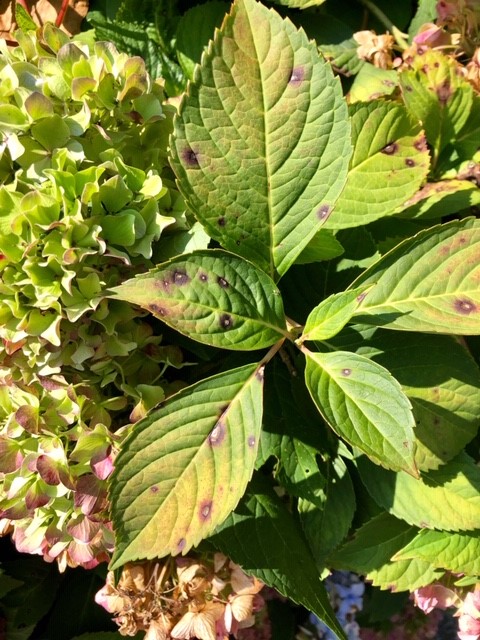What Does Hydrangea Leaves Turning Yellow Do?
Wiki Article
Hydrangea Leaves Turning Yellow Fundamentals Explained
Table of ContentsWhat Does Hydrangea Leaves Turning Yellow Do?The 2-Minute Rule for Hydrangea Leaves Turning YellowHydrangea Leaves Turning Yellow for Dummies7 Simple Techniques For Hydrangea Leaves Turning Yellow
These issues are easy to recognize and fix if you take actions before root rot embed in. A moisture meter can aid assist you to the very best method of correction (Hydrangea Leaves Turning Yellow). Large fallen leaves frequently look sagging throughout the afternoon warmth. When they fail to liven up at night or still look shrivelled in the morning, your plant can be overwatered.Eliminate the plant from the soil and trim out any type of origins that aren't white and turgid (plump). Replant in a brand-new location or function some sand right into the dirt for much better water drainage.
Include a bit of distilled water, stir the active ingredients, and drain the extra water. Put a p, H testing strip in and wait for an analysis.
Sphagnum moss or peat moss stops the soil from compacting and betters dirt drain while likewise increasing the dirt's acidity. You can spread sulfur chips in your hydrangea soil.
Unknown Facts About Hydrangea Leaves Turning Yellow
This is one good factor to repot houseplants on a regular basis (though there are others, such as root growth for instance). It is additionally why houseplants need a much more stringent feeding routine than many exterior plants. When a hydrangea houseplant is lacking in nutrients, its fallen leaves will be the first to reveal the indicators.
A lot of liquid plant food calls for dilution with water to reduce the concentration somewhat. You will certainly likewise need to fertilize the plant by hand and regular intervals. When spring starts in March, it's the active expanding season for numerous houseplants, including hydrangeas. Now, you should begin your feeding routine. Apply liquid fertilizer to your hydrangea because this stuff, as I pointed out formerly, is fast-releasing.
The dripline is the location located under the foliage that is the outermost away from the center of the plant. Rather than using feed to the center of the plant it is best to concentrate it mainly in the external areas Look At This of the pot. If you 'd rather make use of a slow-release plant food such as granular or spike plant food, after that cover either type with some dirt after you put them.
A Biased View of Hydrangea Leaves Turning Yellow

Although the hydrangea is surprisingly frost-resistant, once temperature levels begin getting involved in the 20s, the plant remains in serious threat. If the temperatures are in the reduced 10s, that threat is extra extreme still. Obviously this is even more of a worry about outdoor plants so if you maintain potted hydrangea outside you should bring them inside in very winter conditions and even take into consideration transferring them inside for the duration of the winter.

A dried hydrangea, A huge trouble with several houseplants is root rot. Origin rot happens when you overwater a plant and since it is such a common trouble (particularly with succulents) several houseplant proprietors are fearful of overwatering their plants. Nonetheless, hydrangeas call for even more watering that a lot of various other typical houseplants and can come to be dehydrated when they are underwatered (Hydrangea Leaves Turning Yellow).
The 8-Second Trick For Hydrangea Leaves Turning Yellow
They require massive quantities of water, yet they likewise dislike to expand in standing water or water soaked soil. Be absolutely certain that your hydrangea is dried out because of a lack of water and not because of it be offered way too much water (more on this later). Be mindful prior to you order that watering can that an overwatered hydrangea presents the very same symptoms as an underwatered one! Overwatering is a serious issue if you cut corners on its water requirements even a little bit, your hydrangea will certainly be quick to show it.The most effective means to determine if your hydrangea is undersea is to examine the moisture degrees in the dirt. By making use of an effective yet low-cost dampness and p, H tester, or by sticking your finger into the dirt, you will swiftly find out this here tell if the plant needs water. To get your hydrangea watering routines on the right track, you require to be mindful concerning the moisture levels in its dirt.
When you eliminate your finger from damp dirt it will have tiny quantities of dirt deposit adhered to it. Dry dirt will mean your finger comes out tidy or with dry dirt that is easily blown away. If it's damp, and the plant has yellow leaves after that the plant has actually likely been overwatered and you will certainly need to adhere to the guidance given in the area below.
Report this wiki page